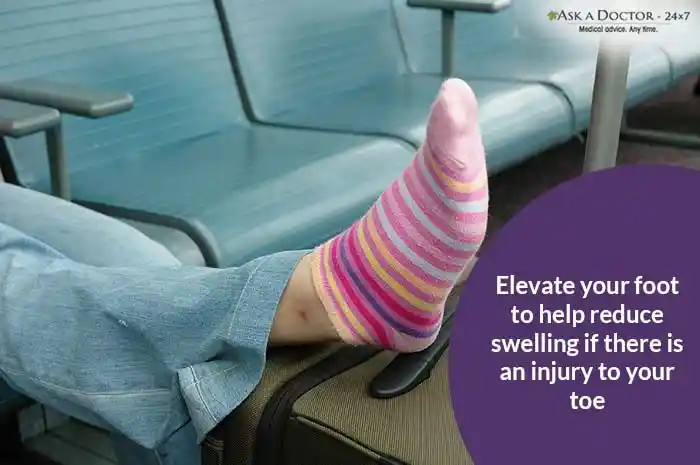Suspecting A Broken Toe? Here's All You Need To Know And DO!
A human foot has 2 bones in the bigger toe and 3 bones each in the other 4 toes. A fractured toe, also known as a “broken toe”, occurs when one or more of these bones are broken.
This is a very common fracture and usually occurs as a result of injury to your toe. This can also happen due to overuse or repetitive stress. Prolonged repetitive movements can cause a stress fracture.
What symptoms will you have in case of a broken toe?
If you have a broken toe, you may have one or more of the following symptoms:
- Severe pain and tenderness
- Swelling
- Redness or bruise
- Difficulty in walking
You will feel severe pain in the injured area. The pain will become more intense if you bear weight on your toe or try moving your toe.
What to do if you suffer a toe injury?

If there is an injury to your foot, you should adopt the R.I.C.E. method to get relief:
- Rest: Give proper rest to the injured area. Keep weight off the leg.
- Ice: Apply cold pack or ice wrapped in a towel to the injured site for 15 minutes 4-5 times a day.
- Compression: Wrap your foot gently in a compressive dressing.
- Elevation: Place your foot on an elevated surface. Raise it above the level of your heart. This will help decrease the swelling.
You can take over-the-counter pain relievers such as ibuprofen and aspirin, and try “buddy taping” your injured toe. Place a piece of cotton or gauze between the injured toe and the adjacent toe, and tape them with surgical tape. This will restrict movement at the site of injury.
Following these steps should help reduce pain and inflammation. If there is no relief even after 24 to 48 hours, you should contact a specialist doctor.
When to seek medical evaluation
It is important to see your doctor if:
- You have a severe injury
- Your great toe is injured
- You feel cold, numbness or tingling sensation at the site of injury
- You have bleeding at the injured area
- You have severe pain and swelling that does not go away
- Your toe turns pale, blue or grey
- You have got an open injury and the underlying tissues are visible
- Your toes have become deformed
- Your self-medication is not giving you any relief from pain and swelling
- There is an infection at the wound site
Diagnosis and treatment for a broken toe

Your doctor will take your medical history and perform a physical examination. If a broken toe is suspected, you may be asked to get an x-ray of the foot done to confirm the diagnosis. Some tests may be performed to check if the sensation and blood supply are intact in that area. If the fracture is not visible in the x-ray, the doctor may order an MRI.
Depending on the type of fracture, your doctor will recommend the treatment. You will be asked to take rest and avoid activities that trigger pain. In cases of a minor fracture, you will be prescribed painkillers and buddy taping. If the bone-ends in your toe have been displaced, the doctor will realign them and put your toes in an immobile state in a plaster cast for a few weeks. You will be given a walking aid such as cane or crutches to help you move about.
It will take 5-8 weeks to heal your toe. You may need to follow up with your doctor for repeat x-rays to ensure that the bone pieces are properly aligned.
Surgery is required in rare scenarios. It is usually performed in cases of crush injuries where the bone breaks into more than 2 pieces.
How to prevent a broken toe

Although broken toe can occur merely by falling, you can make some changes in your lifestyle to prevent the condition. Some of these tips are:
- Eat a healthy diet rich in calcium. This will help build strong bones. Some of the food sources are dairy products, broccoli, fortified cereals, fish, and tofu. You should follow up with your doctor to get your nutrient-level checked.
- Do not wear footwear with a slippery sole. Discard old or worn shoes. These can lead to injury.
- Wear shoes with a wide base of support. Avoid wearing high heels.
- Walk carefully on the wet or slippery floor.
- Increase your speed, duration, and distance gradually, when doing exercise. Do not overstress your feet.
It is crucial to follow the doctor’s advice and take rest if you have a broken toe. A fracture that is not treated may not heal properly and could ultimately lead to arthritis and a change in your gait for the rest of your life. Speak to our Orthopedic online, if you too suspect a broken toe.
Ask a Specialist
Recent Questions


